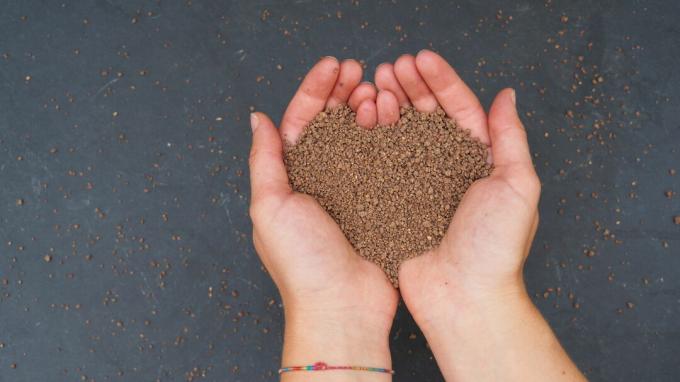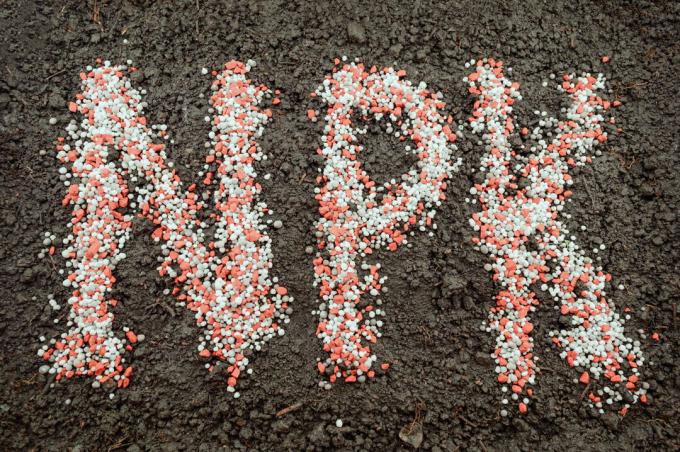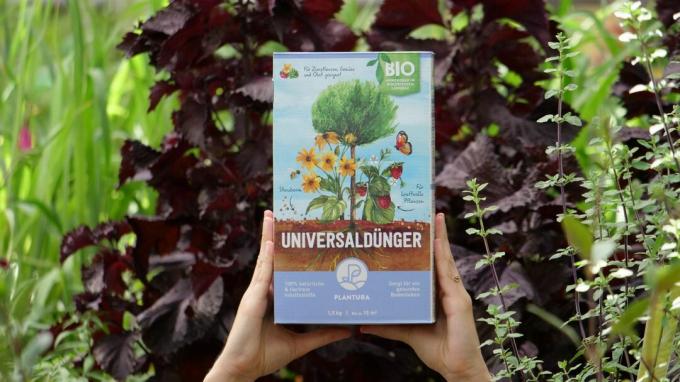Complete fertilizers are fertilizer mixtures that can differ in composition, price and application. Here you get an introduction to the topic.

The complete fertilizer - an omnipotent all-rounder? In this article you will learn what a complete fertilizer is and what its limits are. We also provide you with a few examples of well-known complete fertilizers, name the advantages and disadvantages and give you tips on their use. And to protect you from outrageous offers, we add a rough price classification.
contents
- What are complete fertilizers?
- Which complete fertilizers are there?
- Advantages and disadvantages of complete fertilizers
- Use of complete fertilizers
What are complete fertilizers?
In practice, complete fertilizers are all fertilizers that contain the three plant nutrients nitrogen (N), phosphorus (P) and potassium (K). So every NPK fertilizer is automatically a complete fertilizer. A detailed article on the subject
NPK fertilizer You will find here. To find out about the ingredients of a fertilizer, look for the information on the nutrients it contains on the packaging. The declaration always follows a similar pattern. The plant nutrients - i.e. the chemical compounds in which the nutrients are present - are given as a percentage. The declaration, such as ours Plantura organic tomato fertilizer.4 - 3 - 8 + 2 MgO, means that the fertilizer contains 4% nitrogen, 3% phosphorus, 8% potassium and 2% magnesium.
The order in which the elements are listed is always N - P - K - Mg - S. Additional ingredients are specified in the declaration.

If you are not familiar with the terminology of nutrients, here is a brief overview of the 14 essential nutrient elements of plants:
The main nutritional elements: N, P and K are among the "macronutrient elements", ie the nutrient elements that are required by plants in larger quantities. There are also other macronutrient elements.
Nitrogen (N) is involved in the structure of proteins and DNA, it is also an important component of chlorophyll, the green plant pigment. This enables the plant to photosynthesize.
Phosphorus (P) is also an important part of proteins and DNA. In addition, in plant cells it becomes the "energy currency" of all cells in the form of a special chemical compound. Phosphorus also promotes the formation of flowers and fruits.
Potassium (K) regulates the water balance of the plant and makes it resistant to frost and drought. By supporting the cell wall structure, it promotes stability and resistance to fungal diseases and sucking insects.
Other macronutrient elements: Magnesium (Mg), calcium (Ca) and sulfur (S) are required in somewhat smaller quantities by plants.
The trace elements iron (Fe), manganese (Mn), zinc (Zn), copper (Cu), boron (B), molybdenum (Mo), nickel (Ni) and chlorine (Cl) are required in very small quantities.

Tip: Even if the trace elements are required in very small quantities, they are just as essential for plants as the macronutrients. However, they should only be given to them in very small doses, as this can otherwise damage the plants. It applies to all plant nutrients "The dose makes the poison".
Summary definition of complete fertilizer:
- A complete fertilizer contains the three main nutrients nitrogen, phosphorus and potassium
- It can also contain other macronutrient elements and micronutrient elements
- The declaration is always made in the following order: N - P - K - Mg - S
- The total of 14 essential nutritional elements in plants perform various tasks in plant metabolism
- For all plant nutrients, both a deficiency and an excess can damage the plant
Which complete fertilizers are there?
Complete fertilizers are not all complete fertilizers: Mineral complete fertilizers such as “blue grain” differ fundamentally from organic complete fertilizers in terms of origin and composition.
Complete mineral fertilizers are available in dissolved form as liquid fertilizer and in solid form as fertilizer salt. Coated fertilizer salts are available in small spheres and their shell gives them special properties such as a long-term effect or a demand-oriented release.
Organic complete fertilizers are composed of various substances of plant and animal origin, the nutritional content of which is known. They contain the nutrients "packed" in a natural shell. For a healthy home garden without unnecessary chemicals, organic complete fertilizers are clearly preferable.

Organic-mineral complete fertilizer are mixtures of fertilizers of both categories. These mixtures should skillfully use and combine the special properties of their individual components.
After this brief explanation, we will now introduce you to some well-known complete fertilizers.
Blue grain from Compo-Expert: 12 – 8 – 16 (+3)
Blue grain is a well-known complete fertilizer that has been on the market for many years. It is usually rejected by ecologically oriented gardeners. Due to the lack of organic matter and its immediate availability, there is long-term damage to the Soil and even short-term damage to the plant are more likely than with organic Alternatives. Price: 25 kg costs around 30 euros.
Plantura organic universal fertilizer: 6 – 4 – 4 (+0, +2)
Our Plantura Organic universal fertilizer was developed by us with the greatest care. Due to the high proportion of organic matter, it promotes soil life and is even free of animal ingredients. In addition to nitrogen, phosphorus and potassium, it also contains sulfur and sodium. The potassium content is quite high for an organic fertilizer, so that it does justice to its designation "universal fertilizer". Price: 1.5 kg costs around 15 euros.

Manna special garden fertilizer: 7 - 5 - 9 (+ Mg, + S)
This combined garden fertilizer has a high potassium content, which means that it can be used as a supplement to a purely organic fertilizer. It contains various nitrogen compounds, so the mixture should release nutrients quickly and effectively for a long time. According to the manufacturer, the release depends on the temperature, humidity and activity of the soil. Price: 20 kg costs around 40 euros.
Cuxin DCM liquid fertilizer for house plants (mineral liquid fertilizer): 6 – 4 – 7
The liquid fertilizer for house plants from Cuxin contains quite a lot of nitrogen and potassium. Like all liquid fertilizers, it is intended for regular use via the irrigation water. It makes sense to use an organic fertilizer in addition to this liquid fertilizer, as the liquid fertilizer lacks the long-term effect and it does not contain all macronutrients or trace elements. Price: 800 ml cost between around 14 euros and make 250 liters of irrigation water.
Advantages and disadvantages of complete fertilizers
Anyone who has made it to this sub-point now knows at least one thing: Even complete fertilizers are almost never real all-rounders. Especially if they only meet the minimum requirement to bear this name, i.e. contain N, P and K. Because organic and mineral fertilizers differ so greatly, the advantages and disadvantages are mentioned separately here.
| advantages | disadvantage | |
|---|---|---|
| Complete mineral fertilizers | Fast acting speed | Inferior products are often released too quickly; the consequences can be damage to plants, leaching and outgassing of nutrients |
| Also long-term effect with coating | Long-term effects are not a matter of course, only at an additional cost | |
| High concentration of nutrients | If used alone, damage to soil structure and soil life | |
| Low price | Environmentally harmful due to the extraction of raw materials | |
| Organic complete fertilizers | Easy to use with no risk of over-fertilization | Some slow release products only |
| Improve soil structure and soil life | Many products with low potassium levels, so potassium has to be fertilized separately | |
| Natural long-term effect | A bit expensive | |
| Use of renewable resources | Sometimes unpleasant odor if animal raw materials were used | |
| Also available as a liquid fertilizer | ||
| Also available vegan | ||
| They often contain other important nutrients |
Use of complete fertilizers
At this point you will find some general key points for the correct use of complete fertilizers:
- Even if a fertilizer with N, P and K can be called “complete fertilizer”, a supply with only these three nutritional elements is not sufficient
- Even if a complete mineral fertilizer contained all 14 nutrient elements, application alone would have negative effects on the fertilized soil
- Complete fertilizers never contain all of the nutritional elements, as there are some that shouldn't be mixed for various reasons
- Many garden soils contain large amounts of macro and trace elements due to the entry of organic matter over decades. If these substances are not replenished, however, they will be depleted in the long run
- You should therefore fertilize organically every year and bring in as much organic matter as possible, for example cuttings from beds, lawn clippings or compost
- Never dose mineral fertilizers higher than the recommended application, in order to avoid damage to plants and soil
- Under no circumstances should you fertilize a lot of mineral nitrogen in autumn, as this will then very likely be washed out into the groundwater or released into the atmosphere as ammonia or nitrogen oxide
Tip: Do not use complete fertilizers in conjunction with lime, as this leads to the formation of ammonia and water-insoluble phosphate. You should therefore fertilize lime (calcium) separately with an interval of a few months.
Detailed application recommendations for Lawn fertilization or that Fertilizing fruit trees, we have compiled for you here.



